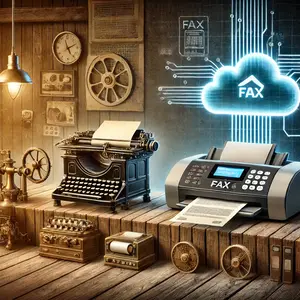Journey of Faxing: From a Distant Idea to Modern Staple
From its 19th-century origins to its modern-day digital evolution, we'll highlight fax's enduring role in secure and efficient communication.
 When we think of faxing today, it probably conjures up images of clunky machines, loud dial tones, and a seemingly endless parade of papers. But what if I told you that faxing wasn’t just a product of the '80s office boom? The concept of faxing—transmitting images or information over long distances—has been around for much longer than most people realize.
When we think of faxing today, it probably conjures up images of clunky machines, loud dial tones, and a seemingly endless parade of papers. But what if I told you that faxing wasn’t just a product of the '80s office boom? The concept of faxing—transmitting images or information over long distances—has been around for much longer than most people realize.
The origins of faxing are deeply intertwined with the human desire to communicate efficiently across distances, long before email or even the telephone came into play. Faxing, as old-school as it might seem today, has a legacy that stretches far beyond the devices we remember from a few decades ago.
The First Sparks of Innovation
Believe it or not, the groundwork for faxing began in the mid-19th century. Back then, inventors were obsessed with finding ways to communicate visually across vast distances, not just with words but with images and written documents. And this was all happening without the internet, the telephone, or even electric lighting!
Early visionaries sought to create machines that could reproduce images or text over wires. They weren’t just thinking about messages; they wanted to transfer whole documents—written, signed, and ready for use—across towns, cities, or even countries. The idea itself was groundbreaking at a time when communication was limited to letters delivered by horse-drawn carriages or basic telegrams.
A Breakthrough in Communication
It wasn’t until the 20th century, when the world was racing towards modernization, that faxing began to take its more recognizable shape. By the mid-1900s, businesses and governments were looking for ways to speed up communication, especially in sectors like banking, legal, and medical fields, where quick document sharing could make or break deals, approvals, or even lives.
This is where faxing found its niche. Early fax machines weren’t pretty or convenient by today’s standards, but they got the job done. Fax allowed documents to be transmitted almost instantly, revolutionizing how companies operated. Deals could now be made across the country without waiting days for paperwork to travel by mail. In a way, faxing was the precursor to our current age of instant communication.
The Evolution into Everyday Life
As faxing technology improved, it became more accessible and started to show up in offices everywhere. You might remember seeing those big, boxy fax machines with rolls of thermal paper and noisy dial tones. These machines were critical for companies that relied on fast and secure communication. Legal firms, banks, and hospitals quickly adopted faxing as an essential part of their daily workflows.
Faxing wasn’t just about speed—it was about security. Faxed documents were (and still are) hard to forge, providing a level of trust that emails and other digital communications struggled to achieve in their early days. And this is why faxing held strong, even as digital technology took off.
Why Faxing Isn’t Going Away
Here’s the interesting part: faxing isn’t just a thing of the past. In many industries—especially healthcare—faxing remains crucial. Why? Because of the level of security and compliance it provides. In a world where data breaches are on the rise and sensitive information is constantly at risk, faxing offers a trusted way to share documents that are difficult to hack or spoof.
For healthcare providers, faxing still plays a key role in protecting patient privacy, keeping medical records secure, and ensuring compliance with laws like HIPAA. In industries like law, government, and finance, faxing continues to be the method of choice when security matters most.
The Future of Faxing: Beyond the Machine
Of course, the days of clunky, noisy fax machines are fading, but that doesn’t mean faxing is obsolete. Far from it. Today, faxing has moved into the cloud, where documents can be sent securely through online platforms. Faxing has evolved to keep up with the demands of modern business, offering the same reliability and security without the physical machines.
Cloud faxing is now the new standard, blending the best of both worlds—speed, security, and the simplicity of digital platforms. This evolution has kept faxing relevant in industries that require airtight security while allowing businesses to streamline their communication processes.
A Legacy That’s Still Evolving
The journey of faxing is far from over. What started as a distant dream in the minds of inventors from centuries past has become a cornerstone of modern business communication. And while the technology has changed, the core principles—speed, security, and trust—remain as important as ever.
Faxing is no longer just a machine sitting in the corner of an office, but a sophisticated, digital tool that continues to shape how businesses, governments, and healthcare providers communicate in the digital age.
![[IGNORE]](https://westfax.com/img/going-green-in-healthcare-how-cloud-faxing-supports-sustainability.webp)
![[IGNORE]](https://westfax.com/img/getting-started-hipaa-compliant-cloud-fax-service.webp)
![[IGNORE]](https://westfax.com/img/how-does-hipaa-compliant-cloud-fax-differ-from-fax-machines.webp)